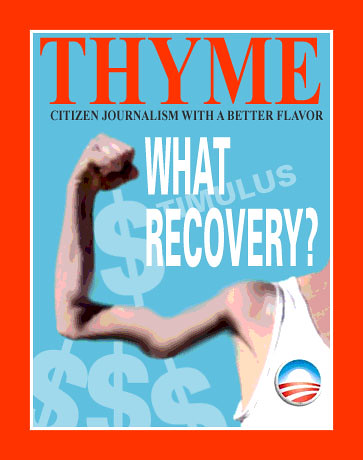
Volume IV, Issue XII
What Wimpy Recovery do You Mean?
This week the 'other' weekly news magazine is asking "why the recovery is wimpy?," at THYME we're asking "what recovery?"
The Beureau of Labor Statistics says: "The number of unemployed persons, at 12.8 million, was essentially unchanged in February. The unemployment rate held at 8.3 percent, 0.8 percentage point below the August 2011 rate.
Among the major worker groups, the unemployment rates for adult men (7.7 percent), adult women (7.7 percent), teenagers (23.8 percent), whites (7.3 percent), blacks (14.1 percent), and Hispanics (10.7 percent) showed little or no change in February. The jobless rate for Asians was 6.3 percent, not seasonally adjusted. The number of long-term unemployed (those jobless for 27 weeks and over) was little changed at 5.4 million in February. These individuals accounted for 42.6 percent of the unemployed. (See table A-12.) Both the labor force and employment rose in February. The civilian labor force participation rate, at 63.9 percent, and the employment-population ratio, at 58.6 percent, edged up over the month.
The number of persons employed part time for economic reasons (sometimes referred to as involuntary part-time workers) was essentially unchanged at 8.1 million in February. These individuals were working part time because their hours had been cut back or because they were unable to find a full-time job.
In February, 2.6 million persons were marginally attached to the labor force, essentially unchanged from a year earlier. (The data are not seasonally adjusted.) These individuals were not in the labor force, wanted and were available for work, and had looked for a job sometime in the prior 12 months. They were not counted as unemployed because they had not searched for work in the 4 weeks preceding the survey. Among the marginally attached, there were 1.0 million discouraged workers in February, about the same as a year earlier. (The data are not seasonally adjusted.) Discouraged workers are persons not currently looking for work because they believe no jobs are available for them. The remaining 1.6 million persons marginally attached to the labor force in February had not searched for work in the 4 weeks preceding the survey for reasons such as school attendance or family responsibilities."
But even as the employment rate "falls" America's long-term unemployment problem isn't going anywhere and the BLS statements above say so between the lines. By the end of 2011 4 million people had been without a job for more than a year according to the Pew Fiscal Analysis Initiative.
Although discouraged workers are often mentioned they are not always counted. Some estimates have real unemployment anywhere from 11% to 17% based on the tendency of unemployed workers to dissapear, either into underemployment or they just stop looking.
Some of us never really make the statistics though. I own my own company and am still here even when there is no work. In 2005 I had all the work I could handle. By 2010 I was working part-time for the Census to supplement the much more meager workload. Last year at this time there was a brief surge in our workload that lasted throught the Summer but I was still "supporting" this business by contract work for another small business person.

So I am inclined to view the above chart from ShadowStats.com [click to read] as more representative of the reality that my colleagues and I are actually seeing. A lot of the reality behind the "better" numbers has to be nothing less than "creative survival." Americans are pretty good at "creative survival!"
What's it All About? Algae?
Additionally, we are faced with rising energy prices and an administration that 'tilts at windmills' while denying permits that would allow our country to become more energy independent. In fact, forget the windmills, the POTUS is now telling us pond scum is the fuel of the future and that nasty old oil is the fuel of the past. Fine, but we haven't mastered the technology to fly a jet powered by pond scum yet. Market forces are providing alternatives to fossil fuels and helping us gain more efficiency with them, but they are still important.
New methods offer safe ways of bringing large amounts of North American oil and gas to market and using them with ever increasing efficiency. We were supposed to have run out of oil in the 'Seventies but a convergence of technologies sees us entering the second decade of the Twenty-first Century with reserves to spare (North American natural gas is being sold to China).





No comments:
Post a Comment